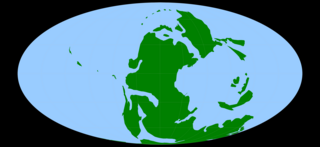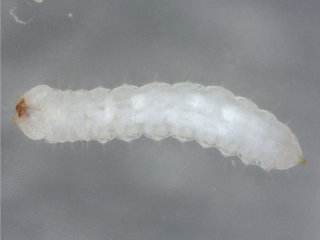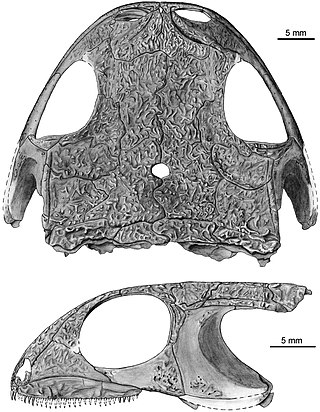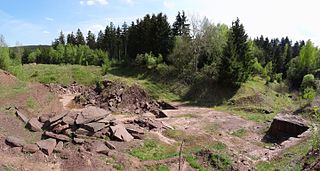
The Permian is a geologic period and stratigraphic system which spans 47 million years from the end of the Carboniferous Period 298.9 million years ago (Mya), to the beginning of the Triassic Period 251.902 Mya. It is the last period of the Paleozoic Era; the following Triassic Period belongs to the Mesozoic Era. The concept of the Permian was introduced in 1841 by geologist Sir Roderick Murchison, who named it after the region of Perm in Russia.

The telephone-pole beetle is a beetle native to the eastern United States and the only living representative of the otherwise extinct family Micromalthidae. Larvae of the beetle live in decaying wood and can be pests to wooden structures, lending them their common name, the 'telephone-pole beetle.'
In the geologic timescale, the Artinskian is an age or stage of the Permian. It is a subdivision of the Cisuralian Epoch or Series. The Artinskian likely lasted between 290.1 and 283.5 million years ago (Ma) according to the most recent revision of the International Commission on Stratigraphy (ICS) in 2022. It was preceded by the Sakmarian and followed by the Kungurian.
The most recent understanding of the evolution of insects is based on studies of the following branches of science: molecular biology, insect morphology, paleontology, insect taxonomy, evolution, embryology, bioinformatics and scientific computing. It is estimated that the class of insects originated on Earth about 480 million years ago, in the Ordovician, at about the same time terrestrial plants appeared. Insects are thought to have evolved from a group of crustaceans. The first insects were landbound, but about 400 million years ago in the Devonian period one lineage of insects evolved flight, the first animals to do so. The oldest insect fossil has been proposed to be Rhyniognatha hirsti, estimated to be 400 million years old, but the insect identity of the fossil has been contested. Global climate conditions changed several times during the history of Earth, and along with it the diversity of insects. The Pterygotes underwent a major radiation in the Carboniferous while the Endopterygota underwent another major radiation in the Permian.

Ctenospondylus is an extinct genus of sphenacodontid synapsid

Palaeohatteria is an extinct genus of basal sphenacodonts known from the Early Permian period of Saxony, Germany. It contains a single species, Palaeohatteria longicaudata.

Cheliderpeton is an extinct genus of temnospondyl amphibian. It lived during the Early Permian in what is now Europe. Fossils have been found from the Ruprechtice horizon of the Intrasudetic Basin of Bohemia in the Czech Republic, as well as the Saar-Nahe Basin of southwestern Germany. Cheliderpeton had a 16 cm skull, and reached about 65 cm in length.

Actinodon is an extinct genus of eryopoidean temnospondyl within the family Eryopidae.

Makowskia is an extinct genus of discosauriscid seymouriamorph known from the early Permian of Boskovice Furrow, in the Czech Republic. It was first named by Jozef Klembara in 2005 and the type species is Makowskia laticephala. The generic name honors Alexander Makowsky for describing the first specimens of discosauriscids from the Boskovice Furrow, and the specific name means “broad” + “head”. Makowskia is known only from one specimen, the holotype SNMZ 26506, a skull and anterior portion of postcranial skeleton. A phylogenetic analysis places Makowskia as the sister taxon to Spinarerpeton.
Ruthenosaurus is an extinct genus of caseid synapsids that lived in what is now southern France during the Early Permian about 285 million years ago. It is known from the holotype MNHN.F.MCL-1 an articulated partial postcranial skeleton. It was collected by D. Sigogneau-Russell and D. Russell in 1970 in the upper part of the M2 Member, Grès Rouge Group, in the Rodez Basin, near the village of Valady, in Occitanie Region. It was first named by Robert R. Reisz, Hillary C. Maddin, Jörg Fröbisch and Jocelyn Falconnet in 2011, and the type species is Ruthenosaurus russellorum.
Vladimir Vasilevich Zherikhin, of the Paleontological Institute, Russian Academy of Sciences, Moscow, was one of the world's leading paleoentomologists and coleopterists. He worked on the palaeontology of the Coleoptera (beetles) and of insects in general, and on the taxonomy of the weevils (Curculionoidea).

The Tambach Formation is an Early Permian-age geologic formation in central Germany. It consists of red to brown-colored sedimentary rocks such as conglomerate, sandstone, and mudstone, and is the oldest portion of the Upper Rotliegend within the Thuringian Forest Basin.

Cummingella is a genus of proetid trilobite in the family Phillipsiidae that lived from the earliest Carboniferous until the last species' extinction in the Middle Permian. Fossils have been found in corresponding marine strata of western Europe, the United Kingdom, and the United States.

The Archer City Formation is a geological formation in north-central Texas, preserving fossils from the Asselian and early Sakmarian stages of the Permian period. It is the earliest component of the Texas red beds, introducing an tropical ecosystem which will persist in the area through the rest of the Early Permian. The Archer City Formation is preceded by the cool Carboniferous swamp sediments of the Markley Formation, and succeeded by the equally fossiliferous red beds of the Nocona Formation. The Archer City Formation was not named as a unique geological unit until the late 1980s. Older studies generally labelled its outcrops as the Moran or Putnam formations, which are age-equivalent marine units to the southwest.
Tshekardocoleoidea is a superfamily in the extinct suborder Protocoleoptera that contains the following families:

Permocupedidae is a family of Protocoleopteran stem group beetles. They first appeared during the Early Permian, and were one of the dominant groups of beetles during the Middle Permian. They became rare in the Late Permian, with only one species known from the Triassic, Frankencupes ultimus from the Middle Triassic (Anisian) Röt Formation of Germany. They are thought to have been xylophagous, which is presumed to be the ancestral ecology of beetles.
Permarachne is an extinct genus of arachnids containing the single species Permarachne novokshonovi from the Permian (Kungurian) of Russia, found in the Koshelevka Formation near the town of Suksun in Perm Krai. It is closely related to modern spiders but unlike them, it has a long thin tail, similar to its relative Attercopus, it is known from the mostly complete holotype PIN 4909/12. It is about 1 cm in size. It initially was thought to be a spider, but is now thought to form a clade with at least its close relative Attercopus, forming the grouping Uraraneida.
Ademosynidae is an extinct family of beetles, known from the Late Triassic to Early Cretaceous. There are at least six genera and 11 species in Ademosynidae. Members of the family were small oval beetles, with a length generally smaller than 1 cm. Characteristics of the family include a pronotum without anterior angles and a rounded anterior margin, and elytra with 9–12 punctate striae. The systematic position of the family within the order Coleoptera is currently uncertain: they can be considered early examples of the suborder Polyphaga, or unusual examples of Archostemata.

Taldycupedidae is an extinct family of beetles primarily known from the Permian period.













